I recently picked up a Macintosh Classic from Craigslist, which looked to be in super good condition. Case was really white, mouse looked to be like new. The only= thing was, it didn't work. When I asked about it, I fully expected it to be blown up and destroyed by a Maxell bomb. But he responded back and said that it did nothing. Literally nothing, no fans, hard drive, nothing. He also said that it had been working just 18 months ago, which was a good sign. He also said there was nothing rattling when shaken, even better!
The day I went to pick it up, he said that he tried turning it on again, and that this time it did something. It had a screen with some really weird lines. Here you can also see how white the computer is. I didn't feel too good about this, because when I asked Techknight about it, he said usually this means the battery exploded. I offered 60 dollars, and he took it. Even if it was exploded, the case and accessories were in such good condition that it was worth it.
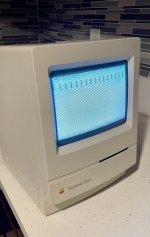
When I got to his house, the first thing I noticed was how white the computer was. I've seen really white computers and have an SE/30 that's in like new condition, but this was pretty white. He also let me open up the computer, which was really cool of him. While I removed the screws, he talked about how this was his first mac he got when he was 12, an the reason he was selling it was because it didn't work anymore. I found getting the case off to be pretty difficult compared to an SE because the top wouldn't come off. In fact, earlier that day I picked up another Mac Classic, sadly bombed which I had the same problem with to get open.
Eventually I popped it off by laying it on the couch and shaking it up and down. I was relieved when I saw there was no huge rust spot on the chassis, and the battery was not exploded. The battery had a date code of XV/10/90, I have no idea what this means but it could be 10/15/90. If this was a Maxell, you bet it would be exploded by now.
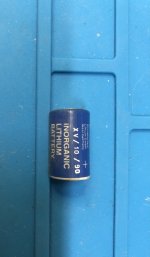
The next day I started to work on the computer. I tried powering it on even though I probably shouldn't have cause it could break something, but I got nothing. No screen, fan, anything. It was dead again, which made me suspect the analog board was having issues. Also I'm not making this up, but bending over the computer, I could smell the fish goo from leaky capacitors. Clearly the analog board needed work.
I got to work recapping the logic board. It looked pretty good, very dusty but no big areas where traces could be broken. It's so weird how tiny the Mac Classic logic board is compared to a Mac SE/30. I like working on one of these much better.

I did see one small part in the middle of the group of 4 capacitors that looked a little troublesome, that one chip especially. The black legs worried me as the traces could be broken leading to those pads.
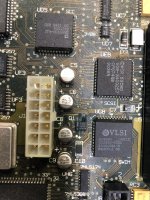
This area looked much better, but I did see a black trace. Can you see it?

The first thing to do was remove the capacitors. I did my usual twist off using pliers to remove the caps. I know many people don't like this way of removing caps, but I've never ripped a pad off the board before using this method. Here are the pads after the twist off:
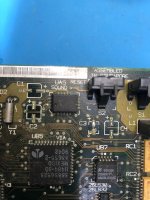
Putting flux on them:
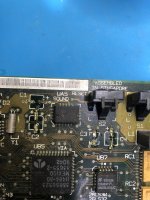
Cleaned up:
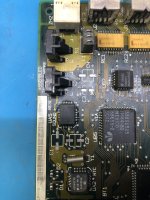
Here is that black trace in case you missed it:

Scraped it with a knife and checked continuity, still good. I used some UV solder mask to cover it.

Now onto recapping. What I do is first tin the right pad, since I'm right handed I hold my soldering iron on my right hand and the tweezers holding the capacitor in my left. Then I add flux to both pads, heat up the right pad, slide the cap into place and let go. I make sure it's straight so it looks nice, then add solder to the other side. Repeat for the next capacitors.
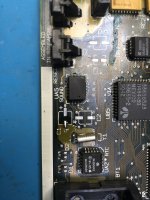
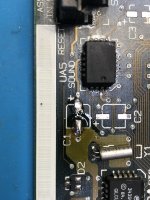
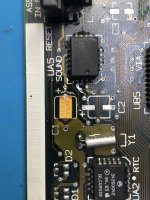
Do you think these capacitors are straight enough? I tried making them as even as possible but they're still a little bit crooked.


Here is the board recapped and cleaned. Along the way I cleaned the board using Q tips and Isopropyl alcohol. I didn't do a full wash, because I figured if it still didn't work I would give it a bath in the ultrasonic cleaner.
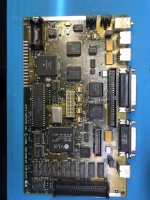
And now.... The moment we've all been waiting for. I put the board back into the computer, and turned it on. Nothing. I didn't really expect anything to happen since it was fully dead before. If the analog board was working it would have at least spun up the fans. Oh well. Luckily, I have a plan B. I originally was going to swap the analog boards with the one from the bombed Mac Classic I picked up before this one, but I realized the connectors where the yoke would plug into were different. I didn't want to risk breaking the CRTs, so in the end I decided to just put the board into the bombed case. I turned it on and.....

YES! It works! The sound is a bit quiet, but that could be due to the analog board and speaker being in an enclosed space next to an exploded battery. I plugged in my Floppy Emu and mouse and booted it up.
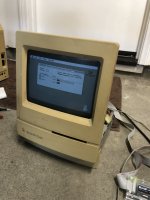
Everything seems to be working. I haven't tested SCSI yet or the internal floppy drive, but there's no reason why they shouldn't work.
And this is where we leave off... On my to do list:
Recap the analog board (need to buy capacitors)
Clean floppy drive
See if original HD is working, if it is then format and reinstall, if it isn't BlueSCSI
Deep clean original case, no need for Retrobright.
The day I went to pick it up, he said that he tried turning it on again, and that this time it did something. It had a screen with some really weird lines. Here you can also see how white the computer is. I didn't feel too good about this, because when I asked Techknight about it, he said usually this means the battery exploded. I offered 60 dollars, and he took it. Even if it was exploded, the case and accessories were in such good condition that it was worth it.

When I got to his house, the first thing I noticed was how white the computer was. I've seen really white computers and have an SE/30 that's in like new condition, but this was pretty white. He also let me open up the computer, which was really cool of him. While I removed the screws, he talked about how this was his first mac he got when he was 12, an the reason he was selling it was because it didn't work anymore. I found getting the case off to be pretty difficult compared to an SE because the top wouldn't come off. In fact, earlier that day I picked up another Mac Classic, sadly bombed which I had the same problem with to get open.
Eventually I popped it off by laying it on the couch and shaking it up and down. I was relieved when I saw there was no huge rust spot on the chassis, and the battery was not exploded. The battery had a date code of XV/10/90, I have no idea what this means but it could be 10/15/90. If this was a Maxell, you bet it would be exploded by now.

The next day I started to work on the computer. I tried powering it on even though I probably shouldn't have cause it could break something, but I got nothing. No screen, fan, anything. It was dead again, which made me suspect the analog board was having issues. Also I'm not making this up, but bending over the computer, I could smell the fish goo from leaky capacitors. Clearly the analog board needed work.
I got to work recapping the logic board. It looked pretty good, very dusty but no big areas where traces could be broken. It's so weird how tiny the Mac Classic logic board is compared to a Mac SE/30. I like working on one of these much better.

I did see one small part in the middle of the group of 4 capacitors that looked a little troublesome, that one chip especially. The black legs worried me as the traces could be broken leading to those pads.

This area looked much better, but I did see a black trace. Can you see it?

The first thing to do was remove the capacitors. I did my usual twist off using pliers to remove the caps. I know many people don't like this way of removing caps, but I've never ripped a pad off the board before using this method. Here are the pads after the twist off:

Putting flux on them:

Cleaned up:

Here is that black trace in case you missed it:

Scraped it with a knife and checked continuity, still good. I used some UV solder mask to cover it.

Now onto recapping. What I do is first tin the right pad, since I'm right handed I hold my soldering iron on my right hand and the tweezers holding the capacitor in my left. Then I add flux to both pads, heat up the right pad, slide the cap into place and let go. I make sure it's straight so it looks nice, then add solder to the other side. Repeat for the next capacitors.



Do you think these capacitors are straight enough? I tried making them as even as possible but they're still a little bit crooked.


Here is the board recapped and cleaned. Along the way I cleaned the board using Q tips and Isopropyl alcohol. I didn't do a full wash, because I figured if it still didn't work I would give it a bath in the ultrasonic cleaner.

And now.... The moment we've all been waiting for. I put the board back into the computer, and turned it on. Nothing. I didn't really expect anything to happen since it was fully dead before. If the analog board was working it would have at least spun up the fans. Oh well. Luckily, I have a plan B. I originally was going to swap the analog boards with the one from the bombed Mac Classic I picked up before this one, but I realized the connectors where the yoke would plug into were different. I didn't want to risk breaking the CRTs, so in the end I decided to just put the board into the bombed case. I turned it on and.....

YES! It works! The sound is a bit quiet, but that could be due to the analog board and speaker being in an enclosed space next to an exploded battery. I plugged in my Floppy Emu and mouse and booted it up.

Everything seems to be working. I haven't tested SCSI yet or the internal floppy drive, but there's no reason why they shouldn't work.
And this is where we leave off... On my to do list:
Recap the analog board (need to buy capacitors)
Clean floppy drive
See if original HD is working, if it is then format and reinstall, if it isn't BlueSCSI
Deep clean original case, no need for Retrobright.
